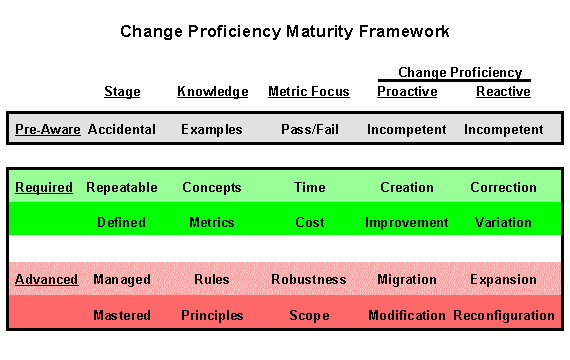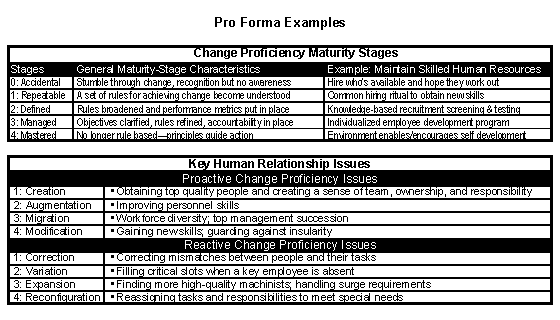 Paradigm Shift
Paradigm ShiftInternational
Agile Enterprise
Reference Model
 Paradigm Shift Paradigm ShiftInternational |
Agile Enterprise |
|
Features: Home | Library |
Corp Info |
(Section A: Part 2 of 4) Change Proficiency Maturity Model A five-stage maturity model framework was recently developed as a tool to assess existing corporate competency at change proficiency, as well as to prioritize and guide an Agility transformation or improvement strategy. The framework is based upon a progression through five stages of working knowledge and strategic focus for practices and procedures, with separate competency tracks for both proactive and reactive proficiencies. The framework is used to build a Change Proficiency Maturity Model for a specific business practice. We focus on change proficiency as a necessary and fundamental enabler for the agile enterprise. We also recognize that an agile enterprise can be as simple as a portfolio management company that constantly reshuffles the inagile resources it controls, or as complex as a vertically integrated organization concerned about the Agility of each of its operating units, which in turn are concerned about the Agility of each of their key business processes. Complexity aside, all enterprises have frequent occasion to weather change, and each does so with its own degree of proficiency, or lack thereof. Some deal with each event as they come, some learn naturally from each event and get better at the next change, and some recognize competitive value in mastering the process of change. Important Definitions
We do not gauge a company's progress toward timeless mastery at change proficiency by accumulating points for practices like teaming, mass customization, virtual partnering, integrated product/process development, and other such very important concepts of the day. Instead, we look for more fundamental capabilities that allow a company to adopt and integrate whatever operating concepts are important today as well as those yet undefined that will become important tomorrow. Implementing today's competitive practices says nothing about the ability to implement tomorrow's. The gauge of process mastery that makes a company timelessly agile measures a continuum from novice to professional at change proficiency. The nature of process improvement and mastery has become a major focus for many industries in the last few years. Maturity models developed by others for process mastery at total quality management (TQM) and also at software development have both provided role models for the Change Proficiency Maturity Model [7]. The framework shown in the accompanying figure is the foundation for the maturity model. The five stages of maturity provide a metric for measuring a company's proficiency on the two axes of interest: proactive and reactive change proficiency. The key change issues for each critical business practice are developed using Response Ability analysis, which refers to a collection of analytical methods based on eight Change Domains, four in the proactive realm and four in the reactive realm [1, 5, 6]. |
 |
The five-stage framework for change proficiency depicted in the accompanying figure moves from "accidental" to "mastery" as the business element under examination develops more competency at adaptation. As a company progresses through these maturity stages there is a specific and different emphasis on change proficiency metrics at each stage. These metrics are associated with the change process itself and refer to the time to affect a change, the cost of making a change, the quality (robustness) of the change process, and the breadth (scope) of the change capability. Of course all of these metrics are interrelated and all are important when evaluating any specific change capability—such as creating a new product or doubling plant capacity to meet unexpected demand—but the process of maturity places special emphasis on individual metrics at each stage. Being able to take advantage of an opportunity while the opportunity is meaningful makes time the initial focus, even if a premium has to be paid. After the "cycle time" of instituting a change is sufficiently under control to hit the "market window," the cost of making these changes enters the spotlight. When both time and cost are acceptable, the focus turns to predictability and consistency, or the quality of the change process. Finally, when good, sound change proficiency capabilities are understood and managed, an organization gains competitive advantage by broadening the range of application. Some level of competency in the change domains of Stages 1 and 2 are required of virtually all companies today. On the proactive side, creation (e.g., product realization) and improvement (e.g., cost reduction) are change capabilities that are at the very focus of today’s competitiveness. Likewise on the reactive side, correction (e.g., fixing/replacing broken resources) and variation (e.g., accommodating customer preferences) are equally at the entry level for playing today’s game. The more advanced Stages 3 and 4 are where preemptive competitive capabilities emerge. On the proactive side, migration competency prepares an organization in advance to weather major transitions as non-events, while modification competency ensures that unique capabilities can be added and eliminated with relative ease. On the reactive side, expansion competency handles opportunities like production-rate doubling or necessities like staff reductions as painless events, while reconfiguration competency reassembles existing resources into new productive configurations easily. These more advanced stages generally require an underlying purposeful design rather than a mere diligent honing of skills. The Accidental Stage is characterized by the lack of any change-process recognition, yet change manages to occur. The actual process is ad hoc: typically exhibiting false starts and retries, unpredictable completion dates and costs, surprising results and side effects, and undesirable reactions from, and effects on, the personnel involved. On the obvious bad side are: grueling overtime, downsizing, multiple reengineering attempts, management fad-of-the-day, fire-fighting, and expediting. The Repeatable Stage is typically based on anecdotal "lessons learned" from past change activities. Specialists and talented SWAT teams are recognized for prior successes and abilities to repeat these in relatively quick time frames. The Defined Stage begins to recognize formal change processes with documented procedures. The base of potentially successful practitioners is broadened as process rather than intuitive talent becomes appreciated. Metrics for the change process are identified and predictability becomes an elusive desire. Typically procedures at this stage are rigid and based on studied experience and analysis. The Managed Stage is characterized by the appointment of change managers (business engineers) with established responsibilities, though they may neither be called such nor recognized as such. An evolving knowledge base of change process fundamentals begins to emerge, appreciation for and participation in the corporate change process is widespread, rigid procedures are loosened, and predictability is the norm. The Mastered Stage is characterized by a principle-based, deep appreciation of adaptability; an understanding that process alone is not sufficient; and a conscious engineering and manipulation of the structures of business practices and organizational infrastructures. Like a flock of birds swooping and turning as a unit, corporate change loses its event status and takes on a constant fluid motion. To assess the maturity of a practice one identifies the knowledge base employed in decision support, the metric focus of active strategies, and the exhibited competencies in both proactive and reactive change—all relative to a previously determined set of change issues. Experience with the Remmele case study found no difficulty in reaching a clear assessment consensus among the three team members for each of the twenty-four business practices. Though it is generally expected that separate assessments of proactive and reactive competencies in a specific practice will result in two separate maturity levels, this was not the case with Remmele. In all instances the proactive and reactive competencies for a specific business practice were identical. The team believes that this is due to the content, strength, and pervasiveness of Remmele's specific corporate ideology, which addresses the concept of continuous change at its core. It is not the purpose of this document to provide a training or users guide for employing the Change Proficiency Maturity Model. This tool and a deeper discourse on its application methodology is a subject for discussion elsewhere. |
 |
|
|
Features: Home | Library |
Corp Info Send email to |